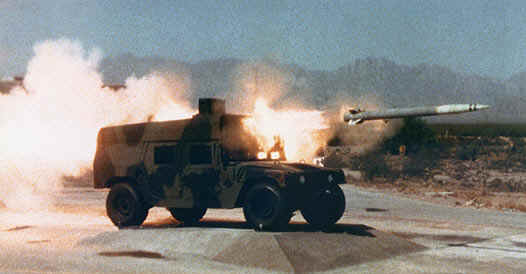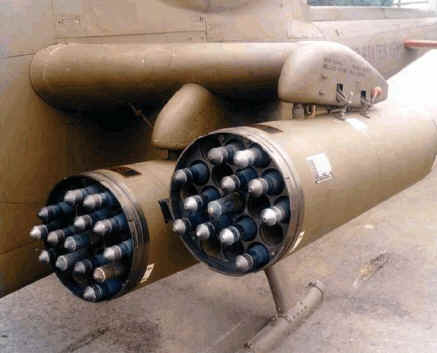The Line-Of-Sight Anti-Tank (LOSAT) missile program is a fraud; it doesn't work. The idea of a supersonic rod penetrator rocket is appealing and should work from a platform with a turret and gun barrel to aim the rocket. Light tanks cannot fire 120mm guns, and even 105mm guns pose problems. However, they could fire large rockets with sufficient power to stop a tank head-on. In fact, the original idea for LOSAT was an unguided rocket fired from a light tank.
Unfortunately, the program was redirected toward a HMMWV platform, a light truck with no turret and no armor. Obviously, there is no way to aim the rocket, so a complex fire control system using "laser beam course update guidance" is planned. Supposedly, this will allow LOSAT to hit tanks within a 20-30 degree arc in front of the HMMWV. This will still require the HMMWV to physically move to engage most targets, which means it must run its engine and generate an infra-red signature. In addition, using a guided missile has boosted the estimated price per missile to an astounding $238,000 per missile, compared to $100,000 per Hellfire missile and $20,000 per TOW.
 The worst part is that its guidance will rarely work. The
LOSAT (left) is designed to strike its target within four seconds after launch.
However, the computerized infrared tracking system is blinded by the launch
blast. It may have just a second to reacquire
the target and abruptly turn the supersonic missile. In addition, rain,
smoke, fog and the rockets own propellant may disrupt the rear mounted
laser guidance. As a result, there will be no chance of hitting anything
with 1000 meters. It is too expensive to fire at non-tank targets, and the lack of
an explosive charge limits its value anyway. As a result, the Army
cancelled LOSAT in 1996, but it has hung on to waste another $215 million
through efforts of corrupt Congressmen.
The worst part is that its guidance will rarely work. The
LOSAT (left) is designed to strike its target within four seconds after launch.
However, the computerized infrared tracking system is blinded by the launch
blast. It may have just a second to reacquire
the target and abruptly turn the supersonic missile. In addition, rain,
smoke, fog and the rockets own propellant may disrupt the rear mounted
laser guidance. As a result, there will be no chance of hitting anything
with 1000 meters. It is too expensive to fire at non-tank targets, and the lack of
an explosive charge limits its value anyway. As a result, the Army
cancelled LOSAT in 1996, but it has hung on to waste another $215 million
through efforts of corrupt Congressmen.
There is no question that the LOSAT missile can easily blast through a tank, so why is it so large? A better idea is to develop an unguided hypersonic 70mm Hydra penetrator which can be fired from rocket pods now in service with helicopters. Even a volley of current high-explosive 70mm rockets can disable a tank with a lucky strike at any of its small weak spots. A HMMWV could be fitted with a pair of M261 rocket pods (below) which carry 19 rocket pods each. They could be fired from an electric turret in small volleys, as the gunner adjusts his own fire. A well trained gunner firing 38 70mm rockets at a group of tanks should be able to put several out of action within seconds, even from the front. These rockets are also highly effective against infantrymen and helicopters.

Three other superior options are discussed in the G2mil library: a 150mm rocket launched from a TOW tube; a ground-based Hellfire missile; and an E-FOG missile. These are smaller missiles than the LOSAT, but the 200lbs MACH 5 LOSAT missile is really overkill. In fact, the entire LOSAT program has drifted into a dead end, but hangs on to collect its annual funding. Cancel LOSAT and buy the powerful anti-tank missiles which already exist.
Carlton Meyer editorG2mil@Gmail.com